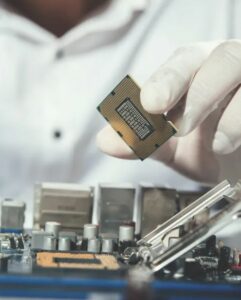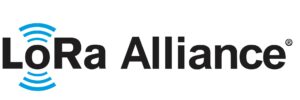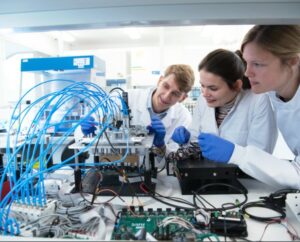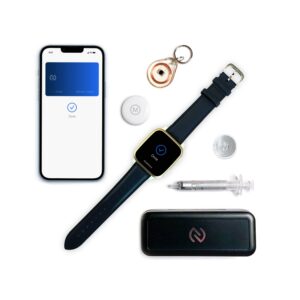Avalue Renity Artemis offers UWB micro-location solution; IoT Companies release relay utilizing LoRaWAN; AccelerComm, Radisys, RFDSP , and TTP partnership features cellular service from space; New ETRI Standard enables NFC-based Internet.
Avalue Renity Artemis Offers UWB Micro-location Solution
Sep 29, 2023Avalue Technology Inc., a global industrial PC solution provider and a Titanium member of the Intel Internet of Things (IoT) Solutions Alliance, will provide a complete range of smart retail, smart healthcare, smart manufacturing, smart transportation, and embedded solutions.
 Avalue indoor positioning solution Renity Artemis’ core competency is its centimeter-accurate ultra-wideband (UWB) location. It can pinpoint position and distance accurately, providing real-time tracking, high penetrability, and anti-interference capability. Its signals can also be hidden within other signals and environmental noise. The Artemis solution supports highly integrated services, enabling connection with management systems, such as MES, WMS, and ERP, via API.
Avalue indoor positioning solution Renity Artemis’ core competency is its centimeter-accurate ultra-wideband (UWB) location. It can pinpoint position and distance accurately, providing real-time tracking, high penetrability, and anti-interference capability. Its signals can also be hidden within other signals and environmental noise. The Artemis solution supports highly integrated services, enabling connection with management systems, such as MES, WMS, and ERP, via API.
The company also offers the Artemis Layout Evaluation Tool, which allows users to detect the number of base stations within an area by uploading a user map to optimize the layout in advance.
In addition, data collected from UWB signals – including fan speed, CPU, HDD, and memory – are presented using a user interface. Real-time alerts may be set up to notify maintenance personnel to prevent system paralysis. Tracking tags only send specification parameters from computing devices; they do not read confidential information. In addition, Renity Artemis’ new anti-fall tag can warn of a fall or collision event in real time, enabling crisis management within the shortest time and improving the outcome of rescue and recovery.
IoT Companies Release Relay Utilizing LoRaWAN
Multiple LPWAN industry companies and LoRa Alliance members have developed a relay feature that uses LoRaWAN connectivity packets. The companies say Semtech, Actility, Arad, and Deviceroy have made the world’s first such commercial implementation, Actility, Arad, and Deviceroy have made the world’s first such commercial implementation, the companies say. This advancement enables LoRaWAN packets from remote, isolated, or hard-to-reach devices to be relayed by battery-operated relay nodes. The relay nodes can be placed in remote locations or areas with weak signal strength due to extreme distances or circumstances, extending the range of existing gateways and networks using LoRaWAN connectivity.
 The extension of coverage with LoRaWAN is intended to keep the cost of LoRaWAN-based IoT solutions at a minimum. The relay feature could be used in applications such as water, gas, and electricity metering, where service level agreements may demand cost-efficient and high-performance coverage for all devices within a geographical area.
The extension of coverage with LoRaWAN is intended to keep the cost of LoRaWAN-based IoT solutions at a minimum. The relay feature could be used in applications such as water, gas, and electricity metering, where service level agreements may demand cost-efficient and high-performance coverage for all devices within a geographical area.
The alliance reports that the relay feature aligns with the LoRa Alliance's commitment to advance and standardize LoRaWAN-based technology to meet the evolving needs of the IoT landscape.
The three vendors – Semtech, Actility, and Deviceroy – have completed interoperability testing and achieved reliable end-to-end bidirectional communication with devices that can connect only through a LoRaWAN-based relay. Water metering solutions company Arad can deploy the relay feature utilizing LoRaWAN within its water meter networks.
According to the companies, introducing the relay feature using LoRaWAN signals a new era in IoT connectivity, enabling more connected solutions across industries by allowing customers to add battery-operated, easy-to-deploy relay nodes that act as network extenders.
AccelerComm, Radisys, RFDSP, and TTP Partnership Features Cellular Service from Space
 IoT 5G company AccelerComm, telecom provider Radisys Corporation, Sub-6GHz solutions specialists RF DSP, and The Technology Partnership – an independent technology and product development company – have teamed up to provide a new solution for low-earth orbit satellites. The LEO Regenerativ e 5G RAN reference solution and architecture, based on 3GPP, provides a 5G regenerative solution tailored to support high-performance 5G services in the Non-Terrestrial Network (NTN) environment.
IoT 5G company AccelerComm, telecom provider Radisys Corporation, Sub-6GHz solutions specialists RF DSP, and The Technology Partnership – an independent technology and product development company – have teamed up to provide a new solution for low-earth orbit satellites. The LEO Regenerativ e 5G RAN reference solution and architecture, based on 3GPP, provides a 5G regenerative solution tailored to support high-performance 5G services in the Non-Terrestrial Network (NTN) environment.
The joint LEO Regenerative reference solution will meet the growing demand for satellite-based enhanced Mobile Broadband (eMB) and IoT services. The companies say that this makes it an ideal solution for businesses and organizations that need to connect people and devices in remote locations or for governments looking to provide Internet access to all citizens.
The solution will be delivered on a space-hardened platform optimized for low power and size. It includes a range of advanced developments in beam-to-cell mapping, beam forming, NTN beam management, and well-defined interfaces to SATCOM infrastructure.
ETRI Releases Standard for NFC-Based Internet
 The Electronics and Telecommunications Research Institute (ETRI) has released the international standard “IETF RFC 9428 Transmission of IPv6 Packets over Near Field Communication (NFC),” which was adopted by the Internet Engineering Task Force to enable Internet connectivity via the 13.56 MHz NFC protocol.
The Electronics and Telecommunications Research Institute (ETRI) has released the international standard “IETF RFC 9428 Transmission of IPv6 Packets over Near Field Communication (NFC),” which was adopted by the Internet Engineering Task Force to enable Internet connectivity via the 13.56 MHz NFC protocol.
NFC technology was previously used to exchange data within 10 centimeters for applications such as contactless payments and NFC tag information access. However, it could now be used for broader Internet communication with the RFC 9428 standard application for short-range wireless communications, making linking to Internet communication possible. For example, offline merchants could use their existing NFC payment services without installing separate, dedicated payment terminals.
The short-range requirements of NFC make it less susceptible to hacking risks compared to Wi-Fi and Bluetooth, providing a more secure channel for data transmissions. The standards association predicts that NFC-based internet access will lead to more significant innovation in the IoT field.

